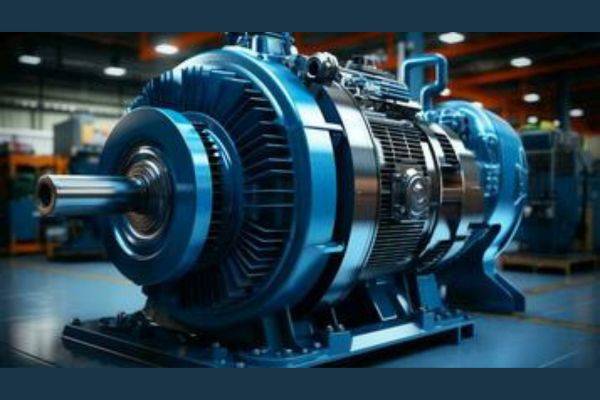The global electric motor market was valued at USD 179.07 billion in 2024 and is projected to reach USD 357.78 billion by 2034, growing at a compound annual growth rate (CAGR) of 7.16% from 2025 to 2034.
The market is experiencing robust growth, fueled by the increasing adoption of energy-efficient systems and the global shift toward renewable energy. Electric motors are integral across a wide range of applications, including industrial machinery, electric vehicles, HVAC systems, and household appliances.
The rising popularity of electric vehicles—especially in developed nations prioritizing sustainability—has significantly boosted demand for high-performance motors. Additionally, the emergence of smart motors equipped with IoT capabilities enhances energy efficiency, real-time monitoring, and operational diagnostics, making them essential for precision-driven industries like manufacturing, healthcare, and clean energy.
Rapid industrialization and urbanization in emerging economies, particularly in the Asia-Pacific region, are also contributing to market expansion. However, challenges such as high initial costs and reliance on rare earth materials for motor production remain. Even so, supportive government policies, incentives for green energy, and advancements in motor design and materials are paving the way for continued growth.
Key Market Highlights (2024)
- Region: Asia-Pacific led the market with a 52.40% revenue share.
- Application: The motor vehicles segment contributed 35.20% of total revenue.
- Motor Type: AC motors held the largest share at 71.40%.
- Power Rating: Motors above 75 kW accounted for the highest revenue share.
- Output Power: Motors with less than 1 HP remained dominant.
- Design Type: Inner rotor motors captured the highest market share.
Emerging Trends in the Electric Motor Market
1. IoT and Smart Motor Integration
Smart electric motors integrated with IoT technology are revolutionizing performance management. These motors enable real-time monitoring, predictive maintenance, and adaptive performance adjustments, significantly reducing downtime and energy use. Their application is growing in sectors demanding high precision and efficiency, such as advanced manufacturing, renewable energy, and healthcare.
2. Demand from HVAC and Home Appliances
Electric motors remain essential to HVAC systems and household appliances like refrigerators, washing machines, and dishwashers. Rising urbanization and living standards are increasing demand for energy-efficient and high-performance motors that support green initiatives and reduced power consumption.
3. Technological Advancements
The electric motor landscape is evolving with the introduction of permanent magnet motors, brushless DC motors, and compact high-efficiency models. These innovations offer superior power-to-weight ratios and longer operational life, while minimizing maintenance. Advances in materials and manufacturing are further enhancing performance across sectors—from industrial machinery to electric vehicles and renewable systems.
4. Mechanization in Agriculture
The shift toward mechanized farming is driving electric motor adoption in agriculture. Motors now power equipment such as irrigation pumps, threshers, and grain elevators, enabling precision farming and improved productivity. As global food demand rises, electric motors—particularly energy-efficient models—play a vital role in the modernization and sustainability of agricultural practices.
5. Government Support and Incentives
Governments worldwide are accelerating the adoption of eco-friendly technologies through incentives, subsidies, and tax rebates. Such policies are directly supporting the use of high-efficiency electric motors in various sectors, especially within electric mobility and renewable energy projects. Mandatory energy efficiency standards for industrial equipment further reinforce this trend.
Electric Motor Market: Segmental Analysis
Motor Type Analysis
AC Motors
AC motors dominate the electric motor market due to their efficiency, durability, and versatility. Operating on alternating current, they are primarily classified into induction and synchronous types. Induction motors are widely used in industrial applications such as conveyor belts, pumps, and HVAC systems for their robustness, though they are less suitable for tasks requiring precise speed control. Technological advancements—like Variable Frequency Drives (VFDs)—have further improved the efficiency and adaptability of AC motors, expanding their use across manufacturing, HVAC, and transportation sectors.
DC Motors:
DC motors are preferred where precise speed control and high torque at low speeds are required, making them ideal for robotics, automotive systems, and compact machinery. They operate on direct current and are categorized as brushed and brushless. While brushed motors are cost-effective, they require frequent maintenance. Brushless DC (BLDC) motors, on the other hand, offer longer lifespans and superior performance with reduced upkeep. The rising demand in electric vehicles and automation is significantly boosting the popularity of BLDC motors across various sectors for their portability, adaptability, and energy efficiency.
Power Rating Analysis
Up to 5 kW:
These motors are used in small-scale applications like household appliances, pumps, fans, and light machinery. Their advantages include compact design, low cost, and energy efficiency. They are also prevalent in automotive secondary systems, such as cooling fans and windshield wipers. The adoption of advanced designs like BLDC motors is further enhancing efficiency and lifespan in this category.
5 kW to 10 kW:
Motors in this range are common in medium-scale industrial and commercial applications, including conveyors, compressors, and HVAC systems. They offer a balanced combination of performance, cost-effectiveness, and reliability. Additionally, these motors are used in small electric vehicles and hybrids. Demand is expected to grow with the push for energy-efficient technologies across commercial and industrial operations.
10 kW to 75 kW:
This power range caters to heavy-duty operations in sectors such as manufacturing, mining, and oil & gas, powering equipment like crushers, pumps, and fans. These motors are integral to high-performance electric vehicles and are increasingly adopting energy-efficient technologies and VFDs to reduce operational costs and comply with energy regulations. Their demand is rising in line with industrial productivity and sustainability goals.
Above 75 kW:
High-power motors above 75 kW are used in large-scale industrial, infrastructure, and energy applications, including power generation, marine propulsion, and heavy machinery. These motors are essential in projects involving wind and hydro energy, where reliability and durability are paramount. Due to high energy consumption, there’s a growing focus on enhancing their efficiency and integrating smart motor technologies. As global infrastructure and renewable energy projects expand, this segment is expected to see sustained growth.
Application Analysis
Industrial Machinery:
Electric motors are indispensable in industrial applications, powering conveyor systems, pumps, compressors, and robotic machinery. Induction motors are favored for their cost-effectiveness and reliability. Technological advancements—like smart motors and energy-efficient designs—support predictive maintenance and energy savings, helping industries align with sustainability initiatives.
Motor Vehicles:
Electric motors play a central role in the automotive sector, from traditional components like starters and alternators to fully electric vehicle propulsion systems. EVs rely on high-efficiency motors such as BLDC and Permanent Magnet Synchronous Motors (PMSM) for their instant torque, compact design, and eco-friendliness, making them the preferred choice in modern automotive engineering.
HVAC Equipment:
Motors in HVAC systems drive compressors, fans, and pumps, ensuring effective temperature regulation and air quality. Energy efficiency is critical in this segment, with variable speed drives and IoT-enabled smart motors improving system performance, sustainability, and predictive maintenance capabilities.
Electrical Appliances:
From refrigerators and washing machines to fans and vacuum cleaners, electric motors are integral to appliance performance. As consumer demand grows for convenience, energy efficiency, and sustainability, innovations like inverter motors and IoT-integrated solutions are making appliances quieter, smarter, and more efficient. This segment is thriving with the proliferation of smart home devices.
Others (Agriculture, Healthcare, Renewable Energy):
This diverse category includes applications in:
- Agriculture: Motors power irrigation systems, grain elevators, and other farming equipment.
- Healthcare: Motors are essential in medical devices such as ventilators, pumps, and imaging systems.
- Renewable Energy: Motors are used in wind turbines and solar tracking systems to maximize energy output.
Electric Motor Market: Regional Analysis
The global electric motor market is segmented into Asia-Pacific, North America, Europe, and LAMEA (Latin America, Middle East, and Africa). Each region exhibits unique growth drivers, industrial dynamics, and technological trends.
Asia-Pacific: The Largest and Fastest-Growing Region
- 2024 Market Size: USD 93.83 billion
- Projected 2034 Market Size: USD 187.48 billion
Asia-Pacific holds the largest share in the global electric motor market and is also the fastest-growing. This growth is fueled by:
- Rapid industrialization and urbanization
- Booming automotive production and electric vehicle (EV) adoption
- Major players like China, India, and Japan, where robust manufacturing industries drive demand for motors in automation and production lines
- Significant investments in infrastructure and renewable energy (e.g., wind, solar, hydropower)
- A rising consumer market for household appliances and HVAC systems
Government initiatives promoting energy-efficient and sustainable technologies, including financial incentives and regulatory mandates, are accelerating electric motor penetration. As the region continues to advance technologically and economically, demand is expected to grow across both industrial and residential segments.
North America: Innovation-Driven Growth
- 2024 Market Size: USD 35.28 billion
- Projected 2034 Market Size: USD 70.48 billion
North America’s electric motor market is shaped by:
- A highly industrialized economy with mature automotive, HVAC, and manufacturing sectors
- Rising adoption of EVs and renewable energy sources such as wind and solar
- Stringent energy efficiency regulations and government incentives driving adoption of advanced motor technologies
- Strong presence of automation and smart technologies
The U.S. leads the region’s market, with significant contributions from Canada and Mexico due to expanding manufacturing and automotive industries. The integration of smart motor technologies, Industry 4.0 initiatives, and increasing emphasis on sustainability and cost-efficiency are expected to further fuel regional demand.
Europe: Sustainability and Regulation-Driven Expansion
- 2024 Market Size: USD 43.33 billion
- Projected 2034 Market Size: USD 86.58 billion
Europe’s electric motor market benefits from:
- Strict energy efficiency standards and a strong push toward sustainable technologies
- Leadership in EV innovation and deployment, particularly in Germany, France, and the UK
- Ambitious climate targets, including carbon neutrality goals, spurring adoption of efficient electric motors in transportation, construction, and manufacturing
- A technologically advanced industrial base fostering smart motor and automation innovations
Europe’s dual advantage of regulatory support and high-tech capabilities makes it a competitive global player, especially in areas such as EV motors, industrial automation, and renewable energy systems.
LAMEA: Emerging Potential Amid Structural Challenges
- 2024 Market Size: USD 6.63 billion
- Projected 2034 Market Size: USD 13.24 billion
The LAMEA region is experiencing steady growth, supported by:
- Industrialization and urban development, particularly in Brazil and Mexico
- Expanding automotive and manufacturing sectors in Latin America
- Middle Eastern nations diversifying their economies through investments in infrastructure and energy
- Growing electrification and industrial activity in parts of Africa
While challenges like economic instability and infrastructure gaps persist, rising foreign investments and government-backed sustainability agendas are unlocking new opportunities. Electric motors are increasingly used in construction, oil & gas, agriculture, and renewable energy projects, driving future demand in this region.

















